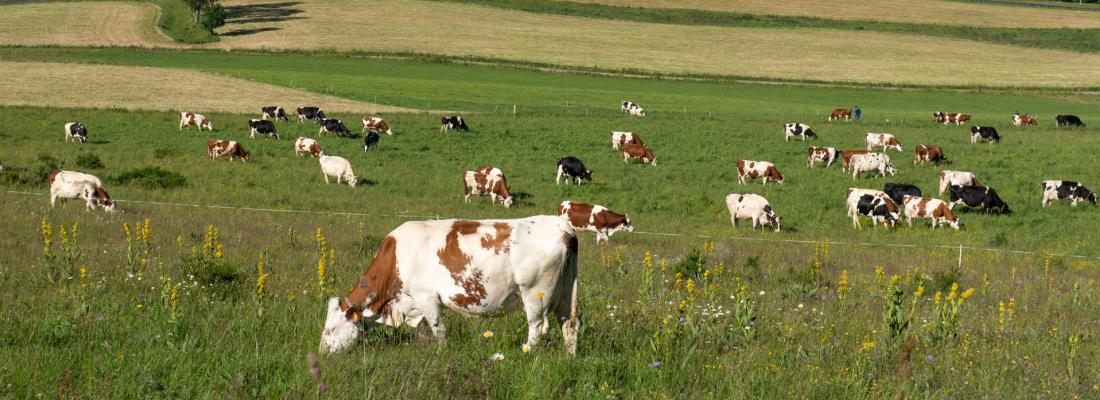Climate change and risks Reading time 3 min
Climate change and cheese quality: the pivotal role of grass feeding
Published on 05 May 2025

Climate change is causing more frequent and intense droughts, affecting the quantity and quality of grass available for dairy cows. In many cases, these droughts can prompt farmers to implement a variety of adaptation strategies, including changes in the cows' rations. In semi-mountainous grassland areas such as the Massif Central in France, farmers generally rely on hay stocks saved for the winter. With climate change, however, these areas are increasingly becoming suitable for growing fodder crops, such as corn, which can be introduced into animal rations. These practices—which until now have been marginal in cheese production areas—raise a number of questions for the local cheese sector, among them the crucial issue of product quality.
Researchers from INRAE and VetAgro Sup have assessed the effects these adaptation practices have on milk and cheese quality by conducting a 4-month trial on an INRAE experimental farm in the Massif Central. Four groups of ten dairy cows were fed diets reflecting the different practices implemented by farmers in the region to cope with climate change and drought. Two groups received rations based on grazed grass: the first was fed 75% grazed grass while the second received 50% hay to simulate a reduction in grass availability due to drought. The other two groups were fed corn silage rations: one ate 75% corn silage and 25% grazed grass, while the last group received no grazed grass and was fed 100% corn silage.
The milk from each group was used to make Cantal-type cheeses. Different samples of milk and cheese were analysed to assess their nutritional and sensory qualities. The results showed that the more grass the cows ate, the richer the milk and cheese were in omega-3 fatty acids, which are beneficial to human health. A group of ten trained panellists assessed the taste, aroma, smell and texture[1] of the Cantal-type cheeses. Cows fed on grazed grass produced smoother, yellower, more aromatic cheeses, while cows fed little to no grass produce whiter, firmer cheeses with milder flavours.
In corn-based systems—a crop which is becoming increasingly popular in semi-mountainous areas—the quality of the cheese is severely compromised by the loss of grazed grass, which is likely to occur as a result of drought. Maintaining fresh grass in corn-based diets, even in small quantities, proved to be crucial in order to preserve the nutritional and sensory quality of the cheese. In grass-based systems, the traditional practice of supplementing cows with hay allows farmers to cope with an episode of drought, and the impact on cheese quality is not as severe.
Numerous other samples were also analysed, from the soil of the grassland to the faeces of rats that had eaten the cheese, as well as the surface of the grass and the cows' udders. These analyses will enable researchers to assess the microbial transfers that occur along the agri-food chain depending on the cows‘ diet, and to study how changes in common practices are likely to impact the microbiota of consumers. The results will be part of a forthcoming publication
[1] 28 criteria were assessed, with scores ranging from 0 (low intensity) to 10 (high intensity): 1 for colour, 10 for odour (lactic, dry fruit, etc.), 4 for taste (salty, bitter, etc.), 8 for aromas, 5 for texture (smoothness, firm, etc.).
The Herbipôle facility has carried out this study as part of the TANDEM research project (of the Holoflux metaprogramme), led by the Joint Research Unit on Cheese. This project brought together a large number of participants: 11 research units involving INRAE researchers (Herbivores Joint Research Unit, Grassland Ecosystem Research Unit, Animal Genetics and Integrative Biology Research Unit, Cardiovascular, Metabolism, Diabetes and Nutrition Laboratory Joint Research Unit, Optimization of processes in Agriculture, Agri-food industry and Environment Research Unit, Agroecology Joint Research Unit, Microbiology, Digestive Environment and Health Joint Research Unit, Laboratory of Environmental Biotechnology Joint Research Unit, Territories Joint Research Unit, Innovation Joint Research Unit, Applied Mathematics and Informatics from Genome to the Environment Joint Research Unit), Fromages de terroirs RMT (joint technology network), Filières sous IG GIS (scientific interest group), Pôle Fromager AOP Massif Central, Chamber of Agriculture of the Puy-De-Dôme, Chamber of Agriculture of the Cantal, Institut de l'élevage, Interprofession du Saint-Nectaire, Comité interprofessionnel des fromages du Cantal, and dairy producers.
Reference
Bouchon M., Martin B., Bord C. et al. (2025). Adaptation strategies to manage summer forage shortages improve animal performance and better maintain milk and cheese quality in grass- versus corn-based dairy systems. Journal of Dairy Science, DOI: https://doi.org/10.3168/jds.2024-25730
